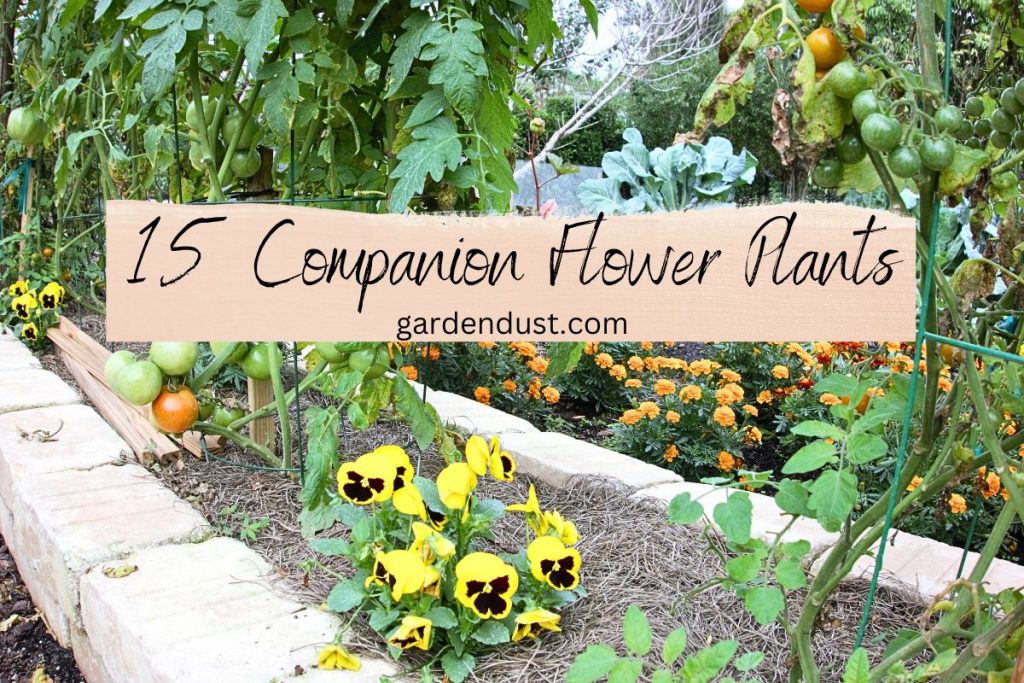Companion planting is a time-honored gardening practice that involves pairing specific plants to create mutually beneficial relationships. Beyond the practical advantages of pest control and improved soil health, companion flowers can bring beauty, color, and texture to your garden beds. In this article, we’ll delve into the world of companion flower plants and explore 15 Companion Flower Plants to Elevate Your Garden that will not only enhance the aesthetics of your garden but also contribute to its overall vitality. Let’s begin….
1. Marigolds and Vegetables

Marigolds are renowned for their pest-repellent properties. Plant them among your vegetables to deter nematodes, aphids, and other harmful insects, while adding vibrant pops of color to your garden.
2. Nasturtiums and Tomatoes

Nasturtiums not only brighten up the garden with their vibrant flowers but also serve as a natural trap for aphids and other pests that often affect tomato plants.
3. Alyssum and Roses

The delicate, fragrant blooms of alyssum can attract beneficial insects like ladybugs, which prey on aphids and other pests that can damage your rose bushes.
4. Borage and Strawberries

Borage’s star-shaped blue flowers not only add beauty to your garden but also attract pollinators. When planted near strawberries, borage can enhance fruit production.
READ ALSO :-How To Grow And Care For African Daisy
5. Lavender and Herbs

Lavender’s soothing fragrance and elegant appearance make it an ideal companion for herbs like rosemary, thyme, and sage. Its presence can also deter pests.
6. Cosmos and Cucumbers

Cosmos flowers provide a burst of color while attracting pollinators to your garden. When paired with cucumbers, cosmos can increase the chances of successful pollination.
7. Sunflowers and Zinnias

Tall sunflowers can offer shade and support to shorter zinnia plants. This combination creates a stunning display of height and color in your garden.
8. Sweet Peas and Beans

Sweet peas not only bring a delightful fragrance to your garden but also offer natural nitrogen fixation to the soil, benefiting beans and other legumes.
9. Daisies and Carrots

Daisies attract beneficial insects like hoverflies, which prey on aphids and other pests. Planting them near carrots can help protect these root vegetables.
10. Chrysanthemums and Chard

Chrysanthemums are effective at repelling a range of pests. Placing them near chard or other leafy greens can help deter insects that might damage the foliage.
11. Bachelor’s Buttons and Broccoli

Bachelor’s buttons, also known as cornflowers, add a touch of charm to your garden. Their vibrant blue blooms can attract pollinators to aid in broccoli production.
12. Zinnias and Herbs

Zinnias’ bright and bold colors make them a striking companion for herbs like basil, mint, and cilantro. Their presence can attract beneficial insects as well.
13. Calendula and Beans

Calendula’s cheerful orange and yellow blooms add beauty while attracting pollinators. Planted near beans, calendula can help deter aphids and other pests.
14. Snapdragons and Peppers

Snapdragons’ vertical growth and range of colors create an eye-catching effect when paired with pepper plants. They can attract beneficial insects as well.
15. Echinacea and Ornamental Grasses

Echinacea, or coneflower, offers beautiful blooms that attract butterflies and bees. When combined with ornamental grasses, the contrasting textures create a dynamic visual appeal.
Companion flower plants offer more than just visual appeal; they play an essential role in creating a balanced and thriving garden ecosystem. By thoughtfully selecting and arranging these flower combinations, you can enhance the beauty of your garden while fostering a healthier environment for your plants. The key is to experiment with different pairings and observe the positive effects they have on each other. As you witness the harmonious partnerships blooming in your garden, you’ll not only enjoy a stunning display of colors but also reap the rewards of a flourishing and vibrant outdoor space. Happy Gardening…






